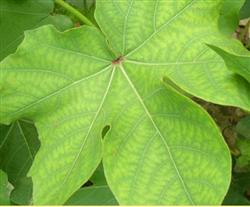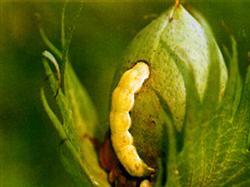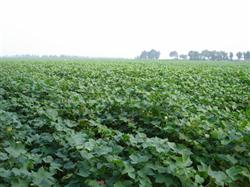What is the difference between cotton Fusarium wilt and Verticillium wilt?

What is the difference between cotton Verticillium wilt and Verticillium wilt? Please introduce the difference between cotton Fusarium wilt and Verticillium wilt as follows: cotton wilt can occur in the whole growth and development period of cotton, but it occurs more seriously in the seedling stage, and it will also occur in the adult plant stage if favorable conditions are encountered. Ralstonia solanacearum type: the leaf suddenly loses water, the leaf droops and wilts, the leaf color is dark green, the leaf becomes soft and thin, the whole plant is green and dry and dies, but the leaf generally does not fall off and the petiole is curved. Yellowing type: it can occur at both seedling stage and adult stage. The yellowing type mostly occurs from the edge of the leaf, the local or whole leaf turns yellow, the leaf dies or falls off at last, and the vessel of petiole and stem turns brown. Purplish red type: mostly occurs in the seedling stage, the diseased leaves appear purple-red disease spots locally or entirely, the veins of the diseased leaves also show reddish brown, the leaves wilt and wither, and the cotton plants die. Shrinking type: it can occur at both seedling stage and adult stage, and the typical symptoms are leaf shrinkage, thickening, dark green leaf color, shortening of internodes, dwarfing of plants, and general non-death. Yellow reticulate pattern: mostly appeared in the seedling stage, the leaf veins of the diseased plants turned green, the mesophyll remained green, the leaves showed yellow reticulation in part or most of the leaves, and finally the whole leaves wilted or fell off. Half yellowing type: mostly occurred in the seedling stage, only half of the infected cotton plants showed yellowing wilt, the other half grew normally, when mixed with Verticillium wilt, the symptoms were dwarf wilt or wilt, and dark brown stripes in xylem could be seen in the diseased stems. Acute wilting type: most of them occur in the adult stage, sunny after heavy rain, acute wilting symptoms often appear in seriously diseased fields, cotton plants suddenly lose water, wilt, green wilt, droop, leaves, buds and flowers fall off to form light culms, and the top of the main stem and fruit branches are scorched. Cotton Verticillium wilt can occur in the whole growth period, but there are few symptoms in the seedling stage under natural conditions. generally, about 40 days after sowing, the cotton plant bud stage begins to occur, and the disease in the middle and later stage is more serious than that in the early stage. Macular type: most of them show symptoms in the budding stage and develop slowly. The diseased plants begin to develop from the lower leaves and gradually develop upward. At the initial stage of the disease, the edges of the leaves curl upward, the flesh spitting between the veins produces light yellow irregular disease spots, and the veins remain green. Generally, the leaves do not die in the early stage and the leaves do not fall off. Leaf withered type: the leaf showed local withered spot or palm-shaped withered spot, and the leaf fell off after death, but the cotton plant generally did not form a light culm. Wilting type: it mostly occurs in the boll setting period, and there can be a kind of acute yellow wilt after heavy rain, which produces water-like light green plaques between the main veins of the leaves, and the leaves wilt and droop quickly. Deciduous type: the damaged plants generally showed the symptoms of the upper leaves first, and the typical symptoms were that the leaves wilted and drooped and fell off rapidly, and the cotton plant had formed a light culm before dying. Click to get more cotton planting technology click to get more food crop planting technology
- Prev

How to control pests when planting cotton?
How to control pests when planting cotton? Please introduce the methods of planting cotton can use the following methods to control insect pests: 1. * Integrated control of leaf mites in cotton field * cotton area is one of the areas with the most serious occurrence of cotton leaf mites in China. Especially after planting cotton with plastic film, it creates conditions for cotton spider mites to enter the cotton field ahead of time.
- Next

What diseases do you need to control when planting cotton?
What diseases do you need to control when planting cotton? Please introduce that the diseases of cotton are different at different stages of growth. The diseases and control of cotton at seedling stage are introduced below for reference. Seedling disease-blight (dead seedlings). After the cotton seedling is unearthed, the yellow-brown disease spot appears at the base of the stem (where it meets the land).
Related
- The first cup of black tea in spring, the flavor and history of tea gardens in Kenya, Africa
- The computer can not only choose potatoes, but also grow tea rice. AI will grow winter oolong tea champion.
- It is not only the inflated tea bitten by insects, but also engraved with the four seasons tea in Beipu.
- The Oriental Beauty Tea Festival in Zhuxian County takes the stage at the weekend to experience the plus-size feast of oil tea.
- & quot; Oriental Beauty Tea & Exploration of Emei in Hsinchu, the hometown of quot;
- The new variety of strawberry "Tainong 1" dessert is the first choice with mellow aroma. Crimson gorgeous
- History of Tea in Taiwan: from Wild Inner Mountain to Export Tea Garden
- Two types of Taiwan Oriental Beauty Black Tea won the British three-Star Award for Childhood Tea Xiang Zhang Jiaqi changed from pilot to champion tea maker.
- Banana species and varieties: the planting history of Taiwan Xianren banana and dwarf banana is long, is banana disease resistant?
- Coffee planting Technology: Qianjie Coffee from Seedling to harvesting

